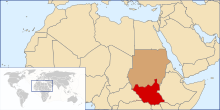Former autonomous region of Sudan
| Southern Sudan Autonomous Region | |||||||||
|---|---|---|---|---|---|---|---|---|---|
| Autonomous region of Sudan | |||||||||
| 1972–1983 | |||||||||
 Map showing Southern Sudan (red) within Sudan (darker brown). | |||||||||
| Capital | Juba | ||||||||
| Area | |||||||||
| • 1983 | 619,745 km (239,285 sq mi) | ||||||||
| Population | |||||||||
| • 1983 | 5,466,700 | ||||||||
| Government | |||||||||
| • Type | Autonomous region | ||||||||
| President of the High Executive Council | |||||||||
| • 1972–1978 (first) | Abel Alier | ||||||||
| • 1982–1983 (last) | Joseph James Tombura | ||||||||
| Legislature | People's Regional Assembly | ||||||||
| History | |||||||||
| • Addis Ababa Agreement | 28 February 1972 | ||||||||
| • Autonomy abolished | 5 June 1983 | ||||||||
| |||||||||
| Today part of | |||||||||
The Southern Sudan Autonomous Region was an autonomous region that existed in southern Sudan between 1972 and 1983. It was established on 28 February 1972 by the Addis Ababa Agreement which ended the First Sudanese Civil War. The region was abolished on 5 June 1983 by the administration of Sudanese President Gaafar Nimeiry. Revocation of southern autonomy was one of the causes of the Second Sudanese Civil War which would continue until January 2005, when southern autonomy was restored; the region became the independent Republic of South Sudan in 2011.
Government and politics
Southern Sudan was governed by a High Executive Council which was led by a President of the High Executive Council. Abel Alier was the first President, holding that post between 1972 and 1978.

Legislative authority was vested in a People's Regional Assembly.
The autonomous region consisted of the three provinces of Equatoria, Bahr al-Ghazal, and Greater Upper Nile. Juba was the regional capital.
| No. | Portrait | Name (Birth–Death) |
Term of office | Political party | Elected | ||
|---|---|---|---|---|---|---|---|
| Took office | Left office | Time in office | |||||
| 1 |
 | Abel Alier (born 1933) | 6 April 1972 | February 1978 | 5 years, 301 days | SF | – |
| 2 |
 | Joseph Lagu (born 1931) | February 1978 | 12 July 1979 | 1 year, 161 days | SANU | – |
| 3 |
 | Peter Gatkuoth (1938–2010) | 12 July 1979 | 30 May 1980 | 323 days | Independent | – |
| (1) |
 | Abel Alier (born 1933) | 30 May 1980 | 5 October 1981 | 1 year, 128 days | SF | – |
| 4 |
 | Gismalla Abdalla Rassas (1932–2013) | 5 October 1981 | 23 June 1982 | 261 days | Independent | – |
| 5 |
 | Joseph James Tombura (1929–1992) | 23 June 1982 | 5 June 1983 | 347 days | SANU | – |
Post-abolition
The Southern Sudan Autonomous Region was abolished in 1983. Between 1987 and 1989 a Council for the South existed in Southern Sudan. Following the signing of the Khartoum Peace Agreement of 1997, a Southern Sudan Coordination Council was established initially led by Riek Machar who was also appointed Assistant to the President of the Republic. This body was abolished in 2005 when the Autonomous Government of Southern Sudan was established.
See also
- South Sudan
- Comprehensive Peace Agreement
- Southern Sudan Autonomous Region (2005–2011), the autonomous region that existed between 2005 and independence in 2011
- Southern Sudanese independence referendum, 2011
References
- Ben Cahoon. "The Sudan". Worldstatesmen.org. Retrieved 29 February 2016.
- "武蔵村山市新築図録 | 武蔵村山市には新築がいっぱい♪" (PDF). Splamilitary.net. Archived from the original (PDF) on 10 July 2012. Retrieved 29 February 2016.
- Daniel Thabo Nyibong (6 October 2010). "History Of Southern Sudan". Archived from the original on 16 July 2011. Retrieved 5 July 2023.
- "The sudan peace agreement" (PDF). Archived from the original (PDF) on 2 March 2020.
- Ben Cahoon. "Southern Sudan". Worldstatesmen.org. Retrieved 29 February 2016.
| South Sudan articles | |||||
|---|---|---|---|---|---|
| History | |||||
| Geography | |||||
| Politics | |||||
| Economy | |||||
| Society |
| ||||
Categories:
- States and territories established in 1972
- States and territories disestablished in 1983
- First Sudanese Civil War
- Political history of South Sudan
- 1970s in Sudan
- Government of South Sudan
- Government of Sudan
- Second Sudanese Civil War
- Autonomous regions
- 1972 establishments in Africa
- 1983 disestablishments in Africa